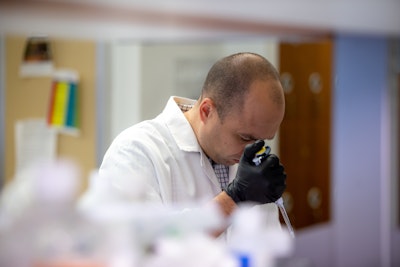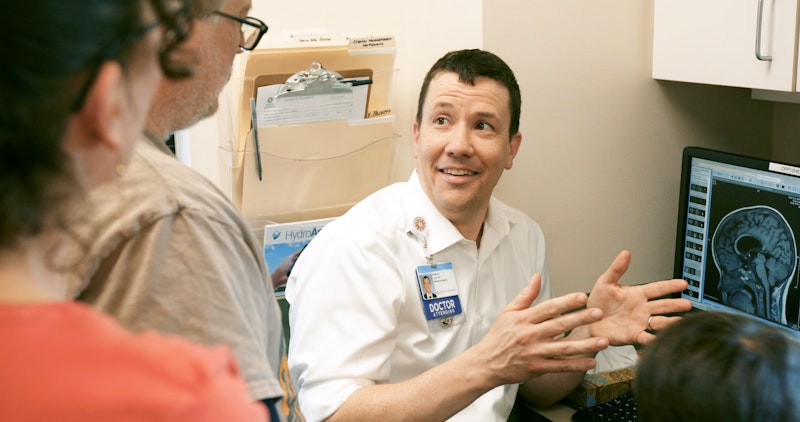Available Resources
The CBTN Scientific Committee is comprised of experts in pediatric brain tumor research from each member institution of the CBTN. Proposed projects which request specimen samples or data are reviewed by members of the CBTN Scientific Committee for approval. This process ensures that the specimens shared by the CBTN are only used for scientifically valid projects. Data from an approved request is typically generated and made available within one-year following the receipt of specimens to the CBTN.
All of the data generated from specimen samples stored in the CBTN's tissue bank is also made available to investigators. As this data grows, it can be used for future approved projects to help identify new treatments for pediatric brain tumors.

Biospecimen
All specimens collected by the CBTN are considered a gift from our donors and their families. The specimen accessioning process follows a detailed workflow to ensure that all of the donated biospecimens are preserved for later use by researchers. With this in mind, we make sure to collect our specimens and store them with the utmost care. By standardizing its' best practices across multiple institutions, the CBTN is positioned to allow for faster, more effective scientific breakthroughs.
Process Overview
Blood is collected from patients to be used as a non-tumor control. The genomic data generated from blood samples can be compared to the genetic information of the tumor to identify the occurrence of specific mutations . Tissue samples are collected from a surgery or biopsy and immediately are flash-frozen using liquid nitrogen vapor. This process preserves the integrity of the tissue DNA/RNA, which will be extracted for scientific projects such as whole genome or RNA sequencing. Tissue in freezing media is extracted at the time of surgery and placed in media for cryopreservation and for use in cell line generation.
Specimen Accessioning
Each month, CBTN member institutions ship biospecimens for processing at the CBTN’s operations center. All specimens are packaged and shipped with dry ice to maintain specimen quality and minimize degradation of DNA or RNA due to thawing. Specimens are accessioned into Nautilus, a laboratory information management system (LIMS). Each submitted specimen is labeled with a unique 2D-barcode. The barcodes are scanned into in LIMS and assigned a specific location within the biorepository. Additional information including weight, volume and any abnormalities are recorded within the specimen’s profile.
Preclinical Models
CBTN offers a variety of preclinical models, developed from donated samples, to support brain tumor research. From cell lines to organoids, these models represent real tumors that can help scientists uncover new disease mechanisms and predict new drug viability. Now available to support your research, you can request CBTN preclinicial models here. Additional cell lines are available through Children's Hospital of Atlanta. An additional materials transfer agreement may be necessary.
Specimen Requests
Requests for specimens are submitted through an online form to the CBTN operations staff. Each request is thoroughly reviewed for accuracy before being sent to the Scientific Committee for approval. Examples of requests include specimens for whole genome sequencing, RNA sequencing and cell line studies.
Data Types
Clinical Data
Clinical data is captured at each surgical and follow up event during a patient’s journey. This data is critical to the analysis of genomic-and-other omics data to allow researchers to understand if therapies have altered the tumor. It also allows researchers to understand outcomes. The clinical data consists of history data, demographic data, surgical data, treatment data including radiation and chemotherapy, trial association and follow up data. Clinical data can be browsed on the Kids First DRC Portal.
Imaging Data
Imaging data in the form of MRIs is collected along with the clinical data. The images, along with the MRI report, are now allowing researchers to understand the extent of the malignancy of different types of pediatric brain tumors. The CBTN collects MRIs at both pre-and-post-surgery, as well as at follow up appointments. The MRI images and MRI reports are currently available for download from the Kids First DRC Portal or Cavatica
Histology Data
Tissue slide images with the diagnostic stains are collected for each tissue specimen submitted to the CBTN. These images along with the Pathology report allow researchers to confirm diagnosis and collaborate on the research projects. The tissue slide images and the Pathology reports are currently available for download from the Kids First DRC Portal or Cavatica.
Genomic Data
For any CBTN-consented subject, the CBTN attempts to generate Whole Genome Sequencing (WGS) and paired RNASeq data as the CBTN collects tumor tissue and matched blood or saliva for each subject and their parents. WGS is performed at 60x with RNAseq at 30x. Data is generated and released regularly. You can browse available files on the Kids First DRC Portal and export them into Cavatica for raw data analysis. Additional you can view the processed data on PedcBioPortal.
The CBTN supports data sharing and collaborative discovery through CBTN-supported portals/platforms, NIH-supported portals/platforms, or other public platforms with approved security and patient privacy protection. The CBTN adheres to NIH guidelines for genomic data sharing and follows the long-standing principles of rapid data release as articulated in the Bermuda and Ft. Lauderdale agreements with no pre-established data embargo periods on quality controlled data. Because the volume of human genomic and phenotypic data contained in the CBTN is substantial and, in some instances, potentially sensitive (e.g., data related to the presence or risk of developing particular diseases or conditions and information regarding family relationships or ancestry), data must be shared in a manner consistent with the research participants’ informed consent, and the confidentiality of the data and the privacy of participants must be protected. As such, access to human genomic data will be provided fully to research investigators who, along with their institutions, have certified their agreement with the expectations and terms of access detailed below.
Proteomics and other Data types
Proteomics Data has been generated for one cohort of CBTN subjects and was released in the Fall of 2018. To see additional data types you can browse availability in the Kids First DRC Portal
Frequently Asked Questions
Can multiple investigators request the same biospecimen?
This depends largely on investigator interest in the samples. However, there are safeguards in place to make sure we know how much tissue is remaining and if a request could potentially deplete a biospecimen.
What data is returned to the CBTN from a project?
All data generated from CBTN specimens must be returned to the CBTN. Raw data is expected back in real time and all other data at the completion of the project.
Can I control who sees the data from my project?
Please refer to the Data Access Agreement. The expectation is that all raw data be released to CBTN via the Cavatica platform in real-time. The individual investigator will inform the decision on when the data can be made available.
How long will it take CBTN Operations to review my request?
The time it takes to review a request is largely dependent on the size and the complexity of the request. Please see the specimen request timeline for more information.
Can I get tissue for a project?
Unless absolutely necessary for the scientific purpose proposed, no tissue will be given out directly from the bank. All extractions will be performed by the biorepository core at CHOP and all cell lines will be generated by the CBTN Cell Line Team.
How is DNA/RNA extracted?
The following process is used for extractions: Qiagen AllPrep DNA/RNA/miRNA method is used for processing. In this method there is no treatment of the DNA with RNase. The RNA samples do undergo a DNAse treatment
Other info about DNA/RNA: The Tissue RNA samples are dissolved in water.
The Tissue DNA samples are in TE (10mM Tris/1 mM EDTA pH8.0)
Blood DNA samples are in TE
